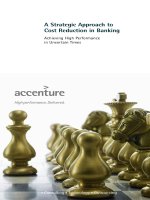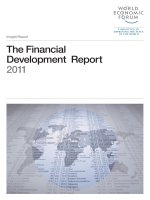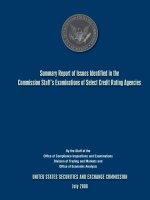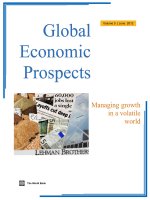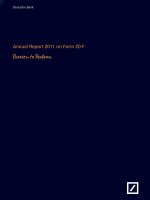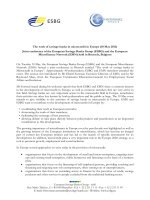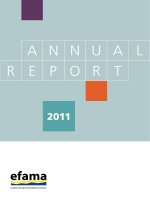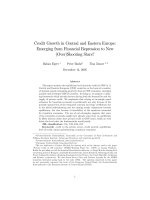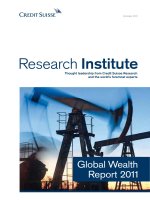Islamic Funds & Investments Report 2011 Achieving Growth in Challenging Times pot
Bạn đang xem bản rút gọn của tài liệu. Xem và tải ngay bản đầy đủ của tài liệu tại đây (3.92 MB, 50 trang )
Islamic Funds & Investments Report 2011
Achieving Growth in Challenging Times
Dear Finance & Investment Leader,
It is with great pleasure that we present to you the 5th annual edition of the Ernst & Young Islamic Funds and Investments Report (IFIR 2011), a ground-breaking original research project developed in
collaboration with leading global professional services organization, Ernst & Young. Given the recent growth and momentum achieved by the global Islamic funds and investments industry in the post-crisis
landscape, it is essential today more than ever that the strong foundations prepared for the industry are now utilized to build critical mass and international scale for the industry.
The Ernst & Young Islamic Funds and Investments Report has over the past 5 years, established itself as critical reference resource for the key decision makers in the global Shari’ah compliant funds and
investments industry. Exclusively launched on-site at a special plenary session of the 7th Annual World Islamic Funds and Financial Markets Conference (WIFFMC 2011), IFIR 2011, with a principal
focus on “achieving growth in challenging times”, will analyze the key trends shaping the industry and will map out future strategic directions that the industry leaders will have to adopt to probe the
emerging landscape of opportunities.
We would like to express our sincere gratitude to Ernst & Young and their Islamic Financial Services Group for investing their considerable talent and resources in developing the Ernst & Young Islamic
Funds and Investments Report.
We hope that the analysis in this year’s Report will provide practical, constructive and valuable insights which will be useful in your own strategic planning activities and will assist your organization in its
quest for success as the global Islamic funds and investments industry enters the next phase of growth. To know more on how your organization can play a part in this initiative in the future, please e-mail
Yours sincerely,
David McLean
Managing Director
The World Islamic Funds & Financial Markets Conference
A MEGA Brand
MEGA Brands: Shaping the Future of the Global Islamic Finance Industry Since 1993
P.O. Box 72045, Dubai, UAE | t. +9714 343 1200 | f+971 4 343 6003
MEGA Brands. MEGA Clients. Market Leaders.
www.megaevents.net
Islamic Funds and Investments
2011
Achieving growth in challenging times
The contents of the Islamic Funds and Investments Report 2011 are based on a combination of quantitative data and
qualitative comments and hence provide a subjective assessment of the current market. All quantitative comments are
based on published information wherever possible. Where published reliable data was not available, qualitative comments
were made which may or may not reflect the true state of affairs. Information has been assimilated from secondary
sources, including published country, industry and institutional information, and primary sources, in the form of interviews
with industry executives.
We are not expressing any assurance on the accuracy or completeness of the information obtained. Although this report
has been documented based on our understanding of Islamic financing activities to include only such activities that are
deemed Shari’a compliant, no Shari’a opinion whatsoever has been taken on this report. Hence, the contents of this
report, in terms of the activities to be carried out, might not necessarily be consistent with Shari’a in all cases, and the
opinion of a Shari’a scholar(s) should be taken before any further steps are made to implement suggestions made in the
report.
Whilst every care has been taken in the preparation of this report, no responsibility is taken by Ernst & Young as to the
accuracy or completeness of the data used or consequent conclusions based on that data, due to the respective
uncertainties associated with any assumptions that have been made. No part of this document may be republished,
distributed, retransmitted, cited or quoted to anyone without prior written permission from Ernst & Young.
Disclaimer
ISLAMIC FUNDS & INVESTMENTS REPORT 2011: ACHIEVING GROWTH IN CHALLENGING TIMES
2
Contents
1. Setting the scene 6
2. Products and asset classes 12
3. Current state of the Islamic fund industry 19
4. The future risk environment 26
5. Conclusion 27
6. Appendix 1: Q&A with Islamic fund managers 28
7. Appendix 2: Islamic fund characteristics 33
8. Appendix 3: Jurisdiction overview 35
9. Team and references 43
3
Executive Brief
Ernst & Young’s Islamic Funds and Investments Report 2011
Dear Investment Executive
Islamic funds industry grew to US$58 billion in 2010, achieving a 7.6% growth. The Islamic fund universe comprises of
some 100 fund managers. Favored asset classes continue to be equities, commodities, Sukuk and alternatives. For
Sukuk assets specially, 2010 was a record year with US$50 billion of total issuance. As the industry continues to realign
itself, there were 23 new Islamic funds launched during the year while 46 funds were liquidated.
The growth is a welcome trend given the industry’s flat performance in recent years. It was primarily driven by market
performance, and only marginally from new net money raised by fund managers. The recovery was also tested by the
evolving geo-political situation across MENA. Secondly, there remain serious concerns on the increasing likelihood of
sovereign debt crisis in Europe and a double dip recession in the US. Both these factors will continue to influence
conventional and Islamic asset management industry going into 2012.
The addressable universe for Islamic fund managers is in excess of US$500 billion, and still growing by at least 10-15%
annually. In the GCC, liquid wealth with Shari’a sensitive investors will add more than US$70b to this pool by 2013.
Our award winning Islamic Financial Services team explored the emerging trends with leading Islamic fund managers and
their ability to assist clients in managing this wealth. It appears that the top three priorities for the industry are:
► Origination and structuring – limited availability of quality Shari’a compliant assets means fewer products to invest in.
Trust in the brand and track record are important factors, and will favor established and larger players.
► Distribution model – access (possibly through alliances) to affluent investors and institutional clients like Waqf, family
businesses, takaful operators etc. is central to future growth.
► Achieving scale – given the 30% fee compression over recent years. A re-look at the revenue and cost
strategy, operating model and most importantly the risk infrastructure, will help set the tone for sustainable growth.
Looking ahead, the challenging times are by no means over. I hope you will find these market insights useful for your
businesses.
Ashar M. Nazim
Islamic Financial Services Leader
Ernst & Young
ISLAMIC FUNDS & INVESTMENTS REPORT 2011: ACHIEVING GROWTH IN CHALLENGING TIMES
4
1. Islamic funds industry benefited from performing markets in 2010 but global
economic uncertainty risks recovery in the future
Islamic funds’ assets under management grew 7.6% to US$58 billion in 2010 but the
performance will be difficult to repeat this year
2. Sukuk, commodities and capital protected funds did well in 2010; bringing new
money into high risk equities will remain a challenge
Investors remain cautious about investing in plain vanilla equity funds; recent decline in market
prices has increased flow into money market funds
3. Achieving scale is even more critical to ensure long term sustainability
Over 70% of fund managers fall below estimated break-even AuM level of US$100 million; big
will get bigger as the going gets tougher to win investors’ trust
4. Global economic scenario, investors’ risk aversion and political aftermath of
the “Arab Spring” are the top three risks in Fund Managers’ minds
Leading fund managers rate the economic situation in Europe and the US as the single biggest
concern on future market performance as no region or market will remain immune in case of a
double dip recession
Key messages
5
Source: National Mutual Funds Association, Ernst & Young analysis
Global Mutual Fund Industry
Note: The data is for 45 countries
Global mutual funds AuM reached US$25.6 trillion in 1Q2011, 35% higher than the
low touched in 2008
Dot-com Crisis
Worldwide Total Net Assets of Mutual Funds (LHS) Worldwide Number of Mutual Funds (RHS)
Estimated AuM
(US$t)
Number of Funds
(‘000)
Financial Crisis
11.3
14.0
16.2
17.8
21.8
26.1
19.0
23.0
24.7
25.6
0
10
20
30
40
50
60
70
80
0
5
10
15
20
25
30
2002
2003
2004
2005
2006
2007
2008
2009
2010
Q1 2011
ISLAMIC FUNDS & INVESTMENTS REPORT 2011: ACHIEVING GROWTH IN CHALLENGING TIMES
6
Source: Eurekahedge, Zawya, Ernst & Young analysis
Global Islamic Fund Management Industry
Number of Funds
Estimated AuM
(US$b)
After three flat years, the global Islamic fund management industry expanded by
7.6% in 2010, reaching US$58 billion in AuM; 13% higher than 2008
Assets Under Management (LHS) Number of Funds (RHS)
34.1
39.5
48.7
51.4
53.9
58
0
100
200
300
400
500
600
700
800
900
0
10
20
30
40
50
60
70
2005 2006 2007 2008 2009 2010
7
This is largely due to market performance and only partially on account of new
money flows; 23 new funds launched, 46 liquidated
Global Islamic Funds - Annual Launches and Liquidations
Source: Zawya, Eurekahedge, Ernst & Young analysis
Number of Funds
Number of Islamic funds launched
Number of Islamic funds liquidated
78
29
46
19
27
23
0
10
20
30
40
50
60
70
80
90
2008
2009
2010
ISLAMIC FUNDS & INVESTMENTS REPORT 2011: ACHIEVING GROWTH IN CHALLENGING TIMES
8
The over dependence on a few institutional investors (Institutional Funds make up
two-thirds of the total new funds launched) is a key structural weakness in Islamic
markets globally (except Malaysia)
Source: Eureka Hedge, Zawya, Ernst & Young analysis
Note: Retail funds are defined as funds that have a minimum initial subscription of US$2,000 or less
Breakup of Retail and Institutional Islamic Funds Launched
43%
32%
33%
33%
57%
68%
67%
67%
2007
2008
2009
2010
Institutional Funds
Retail Funds
0
10
20
30
40
50
60
70
80
90
100
%
9
Shari’a sensitive investors tend to park money with banks rather than investing in
Islamic funds – which constitute only 5.6% of the US$1 trillion industry
Source: Central Banks’ Reports, Securities Commission Malaysia, DataMonitor, Eureka Hedge, Zawya, Ernst & Young analysis
Asset Under Management to Total Banking
Deposits
AuM to Banking Deposits
Size of Fund Management Industry to
Total Industry Size (2010)
Islamic Financial Services Industry
Text
► Other AuM includes off balance sheet direct investments
managed by banks and investment companies and restricted
profit sharing accounts
► Islamic funds represent only 5.6% of the total Islamic
financial services industry
Total Industry
US$ 939 b
Islamic Assets
Managed
US$321 billion
31%
Islamic
Funds
5.6%
Estimated Islamic Finance
Assets US$ 1,033 billion
14%
15%
9%
10%
10%
25%
20%
29%
33%
171%
180%
133%
144%
143%
0%
20%
40%
60%
80%
100%
120%
140%
160%
180%
200%
2006
2007
2008
2009
2010
Saudi Arabia
Malaysia
USA
Key messages
1. Islamic funds industry benefited from performing markets in 2010 but global
economic uncertainty risks recovery in the future
Islamic funds’ assets under management grew 7.6% to US$58 billion in 2010 but the
performance will be difficult to repeat this year
2. Sukuk, commodities and capital protected funds did well in 2010; bringing new
money into high risk equities will remain a challenge
Investors remain cautious about investing in plain vanilla equity funds; recent decline in market
prices has increased flow into money market funds
3. Achieving scale is even more critical to ensure long term sustainability
Over 70% of fund managers fall below estimated break-even AuM level of US$100 million; big
will get bigger as the going gets tougher to win investors’ trust
4. Global economic scenario, investors’ risk aversion and political aftermath of
the “Arab Spring” are the top three risks in Fund Managers’ minds
Leading fund managers rate the economic situation in Europe and the US as the single biggest
concern on future market performance as no region or market will remain immune in case of a
double dip recession
ISLAMIC FUNDS & INVESTMENTS REPORT 2011: ACHIEVING GROWTH IN CHALLENGING TIMES
10
Key messages
1. Islamic funds industry benefited from performing markets in 2010 but global
economic uncertainty risks recovery in the future
Islamic funds’ assets under management grew 7.6% to US$58 billion in 2010 but the
performance will be difficult to repeat this year
2. Sukuk, commodities and capital protected funds did well in 2010; bringing new
money into high risk equities will remain a challenge
Investors remain cautious about investing in plain vanilla equity funds; recent decline in market
prices has increased flow into money market funds
3. Achieving scale is even more critical to ensure long term sustainability
Over 70% of fund managers fall below estimated break-even AuM level of US$100 million; big
will get bigger as the going gets tougher to win investors’ trust
4. Global economic scenario, investors’ risk aversion and political aftermath of
the “Arab Spring” are the top three risks in Fund Managers’ minds
Leading fund managers rate the economic situation in Europe and the US as the single biggest
concern on future market performance as no region or market will remain immune in case of a
double dip recession
11
Equity funds performed in 2010 as markets recovered but the future is likely to be
volatile mainly due to economic problems in Europe and the US
Islamic and Conventional Indices
Index return
Islamic Equity Funds - Average Returns
Top Quartile Return Weighted Average Return
Source: MSCI, Zawya, Eurekahedge, Ernst & Young analysis
Note: Data includes returns of 254 funds
- 60
- 50
- 40
- 30
- 20
- 10
0
10
20
%
MSCI World Islamic Index MSCI World Index Standard Core
Aug 13 2007
Dec 13 2007
Apr 13 2008
Aug 13 2008
Dec 13 2009
Dec 13 2010
Apr 13 2011
Apr 13 2009
Dec 13 2010
Apr 13 2010
Aug 13 2011
Aug 13 2010
Aug 13 2009
41.7
-10.4
48.6
13.2
17.4
-41.8
20.9
4.4
-50
-40
-30
-20
-10
0
10
20
30
40
50
60
2007
2008
2009
2010
%
ISLAMIC FUNDS & INVESTMENTS REPORT 2011: ACHIEVING GROWTH IN CHALLENGING TIMES
12
Assets Under Management of Islamic Funds by Categories (2010)
22.6 39%
15%
7.8 13%
6.8 12%
10%
8.7
5.7
5.3 9%
Equity Other*Commodities Fixed Income Real Estate Money Market Total
1.1
Balanced
Figures in US$b
2%
58
Equity dominates the overall AuM which remains concentrated in traditional asset
classes
Source: Zawya, Eurekahedge, Ernst & Young analysis
*Note: Other includes alternative investments and feeder funds
13
0
50
100
150
200
250
300
350
400
450
0
10
20
30
40
50
60
MENA Sukuk Size Rest of World Sukuk Size Number of Sukuk
2010 proved to be a record year for global Sukuk issues with over US$50 billion
raised; Islamic fixed income funds continued to perform well
Source: IFIS, Zawya Sukuk Monitor, Eurekahedge, Ernst & Young analysis
Global Sukuk Issuance
Islamic Fixed Income Funds - Average Returns
*Deals rumored/announced/delayed
%
US$b Number
Top Quartile Return Weighted Average Return
Note: Data includes returns of 49 funds
8.2
5.5
11.6
16.5
2.4
-0.1
4.4
3.4
-2
0
2
4
6
8
10
12
14
16
18
2007
2008
2009
2010
ISLAMIC FUNDS & INVESTMENTS REPORT 2011: ACHIEVING GROWTH IN CHALLENGING TIMES
14
Global commodity prices continued to rise in 2010 albeit at a slower pace than in
2009; the surge in gold and silver prices accounts for more than 80% of the Islamic
Commodity Funds’ performance
Source: Merrill Lynch, Bloomberg, Eurekahedge, Zawya, Ernst & Young analysis
Merrill Lynch Commodity Excess Return Index
Islamic Commodity Funds - Average Returns
%
Top Quartile Return Weighted Average Return
Note: Data includes returns of 13 funds
21.3
2.5
56.5
27.6
8.0
-15.1
29.0
18.0
-20
-10
0
10
20
30
40
50
60
70
2007 2008 2009 2010
0
100
200
300
400
500
600
700
800
900
25-Oct-05
25-Feb-06
25-Jun-06
25-Oct-06
25-Feb-07
25-Jun-07
25-Oct-07
25-Feb-08
25-Jun-08
25-Oct-08
25-Feb-09
25-Jun-09
25-Oct-09
25-Feb-10
25-Jun-10
25-Oct-10
25-Feb-11
25-Jun-11
15
Money market funds lost some attraction as stability returned in 2010, but are likely
to perform well going forward despite a low profit rate environment due to renewed
worries on global financial situation
Source: Bloomberg, Eurekahedge, Zawya, Ernst & Young analysis
USD 3 Month LIBOR
Islamic Money Market Funds - Average Returns
%
Top Quartile Return Weighted Average Return
Note: Data includes returns of 28 funds
6.5
5.6
4.1
5.5
3.4
2.5
-1.9
1.7
-3
-2
-1
0
1
2
3
4
5
6
7
2007
2008
2009
2010
0
1
2
3
4
5
6
7
3-Jan-05
3-May-05
3-Sep-05
3-Jan-06
3-May-06
3-Sep-06
3-Jan-07
3-May-07
3-Sep-07
3-Jan-08
3-May-08
3-Sep-08
3-Jan-09
3-May-09
3-Sep-09
3-Jan-10
3-May-10
3-Sep-10
3-Jan-11
3-May-11
%
ISLAMIC FUNDS & INVESTMENTS REPORT 2011: ACHIEVING GROWTH IN CHALLENGING TIMES
16
Property prices have stabilized in most markets or the sharp declines have been
arrested; investors continue to remain cautious about investing in real estate
Source: Bloomberg, Eurekahedge, Zawya, Ernst & Young analysis
Global REIT Index
Islamic Real Estate Funds - Average Returns
%
Top Quartile Return Weighted Average Return
16.4
13.8
11.3
12.9
3.5
-12.4
-2.9
2.7
-15
-10
-5
0
5
10
15
20
2007 2008 2009 2010
Note: Data includes returns of 12 funds
0
50
100
150
200
250
21-Oct-05
21-Feb-06
21-Jun-06
21-Oct-06
21-Feb-07
21-Jun-07
21-Oct-07
21-Feb-08
21-Jun-08
21-Oct-08
21-Feb-09
21-Jun-09
21-Oct-09
21-Feb-10
21-Jun-10
21-Oct-10
21-Feb-11
21-Jun-11
17
Key messages
1. Islamic funds industry benefited from performing markets in 2010 but global
economic uncertainty risks recovery in the future
Islamic funds’ assets under management grew 7.6% to US$58 billion in 2010 but the
performance will be difficult to repeat this year
2. Sukuk, commodities and capital protected funds did well in 2010; bringing new
money into high risk equities will remain a challenge
Investors remain cautious about investing in plain vanilla equity funds; recent decline in market
prices has increased flow into money market funds
3. Achieving scale is even more critical to ensure long term sustainability
Over 70% of fund managers fall below estimated break-even AuM level of US$100 million; big
will get bigger as the going gets tougher to win investors’ trust
4. Global economic scenario, investors’ risk aversion and political aftermath of
the “Arab Spring” are the top three risks in Fund Managers’ minds
Leading fund managers rate the economic situation in Europe and the US as the single biggest
concern on future market performance as no region or market will remain immune in case of a
double dip recession
ISLAMIC FUNDS & INVESTMENTS REPORT 2011: ACHIEVING GROWTH IN CHALLENGING TIMES
18
Key messages
1. Islamic funds industry benefited from performing markets in 2010 but global
economic uncertainty risks recovery in the future
Islamic funds’ assets under management grew 7.6% to US$58 billion in 2010 but the
performance will be difficult to repeat this year
2. Sukuk, commodities and capital protected funds did well in 2010; bringing new
money into high risk equities will remain a challenge
Investors remain cautious about investing in plain vanilla equity funds; recent decline in market
prices has increased flow into money market funds
3. Achieving scale is even more critical to ensure long term sustainability
Over 70% of fund managers fall below estimated break-even AuM level of US$100 million; big
will get bigger as the going gets tougher to win investors’ trust
4. Global economic scenario, investors’ risk aversion and political aftermath of
the “Arab Spring” are the top three risks in Fund Managers’ minds
Leading fund managers rate the economic situation in Europe and the US as the single biggest
concern on future market performance as no region or market will remain immune in case of a
double dip recession
Scale remains a key issue for the Islamic fund industry worldwide; only 30% of
Islamic fund managers have more than US$100 million in AuM and top 10 have ~80%
market share
Number of Islamic Fund Managers by Assets Under Management (2010)
Source: Eurekahedge, Zawya, Ernst & Young analysis
Total AuM (US$m)
79
32
18
10
20
9
11
22
< 25 25 -50 50 -75 75 -100 100 -200 200 -300 300 -500 > 500
64% of Fund Managers have
less than US$75m AuM
19
A comparison with conventional investment managers reflects the infancy stage of
the Islamic funds industry; the top 25 conventional fund manager is 50 times the size
of the largest Islamic fund manager
Top 25 Global Asset Managers (2009)
Source: Towers Watson
0 500 1000 1500 2000 2500 3000 3500 4000
MetLife
Franklin Templeton
Wells Fargo
Aviva
Generali Group
Northern Trust Global
Prudential Financial
Legg Mason
Natixis
Bank of America
HSBC Holdings
Goldman Sachs Group
UBS
Credit Agricole
Bank of New York Mellon
Capital Group
JPMorgan Chase
Deutsche Bank
BNP Paribas
AXA Group
Vanguard Group
Fidelity Investments
Allianz Group
State Street Global
BlackRock
AuM US$b
ISLAMIC FUNDS & INVESTMENTS REPORT 2011: ACHIEVING GROWTH IN CHALLENGING TIMES
20
A comparison with conventional investment managers reflects the infancy stage of
the Islamic funds industry; the top 25 conventional fund manager is 50 times the size
of the largest Islamic fund manager
Top 25 Global Asset Managers (2009)
Source: Towers Watson
0 500 1000 1500 2000 2500 3000 3500 4000
MetLife
Franklin Templeton
Wells Fargo
Aviva
Generali Group
Northern Trust Global
Prudential Financial
Legg Mason
Natixis
Bank of America
HSBC Holdings
Goldman Sachs Group
UBS
Credit Agricole
Bank of New York Mellon
Capital Group
JPMorgan Chase
Deutsche Bank
BNP Paribas
AXA Group
Vanguard Group
Fidelity Investments
Allianz Group
State Street Global
BlackRock
AuM US$b
Source: Zawya, Eurekahedge, Ernst & Young analysis
Average Management Fee of Islamic Funds
A 30% compression in management fee since 2007 has added to Islamic fund
managers’ worries in an already tough market; achieving an optimum AuM size and
efficiency of operations are needed for survival
2007 2008 2009 2010 Q1 2011
1.00%
1.44%
1.39%
1.20%
1.15%
High
Low
1.75%
0.50%
10.00%
0.03%
Average
5.50%
0.30%
2.00%
0.35%
2.00%
0.05%
Note: Data includes stated management fees of 369 Islamic funds
21
Based on the average asset management fee of 1%, AuM of at least US$100 million is
required for a fund manager to break-even
Source: Industry interviews, Annual Reports, Ernst & Young analysis
Note: The methodology for the breakeven calculation is based on the average annual operational costs for listed equity mutual funds. It is important to note that costs/AuM will
vary for more sophisticated asset classes
Break Even Management Fee for Selected AUM Levels
0
25
50
75
100
125
150
175
200
4.03.53.02.52.01.51.00.5
Assets Under Management (US$m)
Management fee (%)
Industry Average Management Fee
ISLAMIC FUNDS & INVESTMENTS REPORT 2011: ACHIEVING GROWTH IN CHALLENGING TIMES
22
Based on the average asset management fee of 1%, AuM of at least US$100 million is
required for a fund manager to break-even
Source: Industry interviews, Annual Reports, Ernst & Young analysis
Note: The methodology for the breakeven calculation is based on the average annual operational costs for listed equity mutual funds. It is important to note that costs/AuM will
vary for more sophisticated asset classes
Break Even Management Fee for Selected AUM Levels
0
25
50
75
100
125
150
175
200
4.03.53.02.52.01.51.00.5
Assets Under Management (US$m)
Management fee (%)
Industry Average Management Fee
Source: Pew Research Center, Ernst & Young analysis
100m +
50 - 100m
10 – 50m
5 – 10m
1 – 5m
Estimated
Muslim
Populations
in 2010
India
~177m
Indonesia
~204m
Pakistan
~178m
Bangladesh
~148m
Turkey
~74m
Egypt
~80m
Nigeria
~75m
Algeria
~34m
Morocco
~32m
Iran
~74m
Global Estimated Muslim Populations in 2010
Under 1m
The fundamental case for Islamic funds industry remains strong; Muslim
populations are growing globally and an estimated 1.5 billion Muslims constitute
~20% of world population
Malaysia
~17m
GCC
~36m
23

